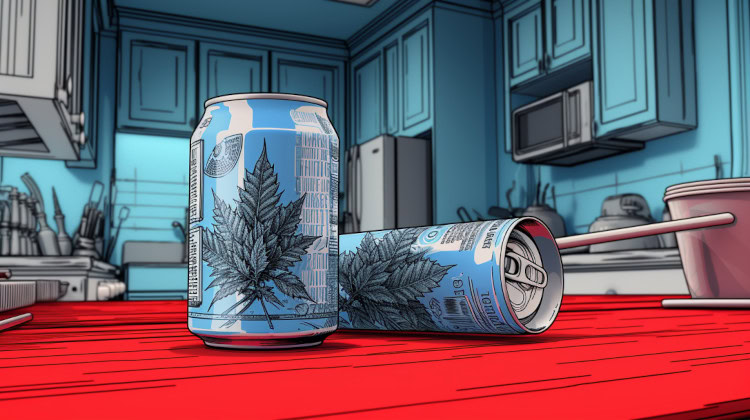In This Article
Key Takeaways
- Cannabis edibles may provide various options for migraine relief, but selecting the right product can be challenging for new patients.
- Dosage, ratios of THC to CBD, and additional ingredients will make a big difference in how effective edibles are.
- Avoid edibles high in migraine triggers, like caffeine and sugar.
The edibles marketplace for migraines offers many options, including gummies, chocolates, baked goods, and beverages. Edibles can contain various concentrations of THC, CBD, and other cannabinoids, allowing patients to select one that suits their personal preferences and medical needs.
When researching the best edibles for migraines, all these choices can be overwhelming, especially for those new to cannabis. Gummies for migraines are popular, but an effective selection is more than choosing a favorite flavor or form. It’s helpful to consider the other added ingredients and cannabinoid profiles that may best target migraine symptoms.
Can Weed Help with Migraines?
Both research and anecdotal reports suggest cannabis may be a suitable treatment method for some migraine patients. A study of patients with headache disorders found cannabis use improved both migraines and general health-related quality of life.1
How does cannabis help with migraine management? Cannabis interacts with the body’s endocannabinoid system (ECS), which is involved in regulating pain and inflammation. Cannabinoids like THC and CBD may help reduce the frequency and intensity of migraines by modulating serotonin pathways, reducing inflammation, and blocking pain signals.2
Changes in serotonin levels may lead to migraine development. Anandamide (AEA), an endocannabinoid naturally produced by the body, interacts with serotonin receptors in the brain. It enhances the activity of receptors that help reduce migraine pain (5-HT1A) while inhibiting receptors that can trigger migraines (5-HT2A). This dual action supports the use of cannabinoids in both acute migraine relief and prevention.
Cannabinoids also have dopamine-blocking and anti-inflammatory properties. This action means they can help reduce the inflammation and overactivity of brain chemicals that lead to migraines. Additionally, cannabinoids may prevent migraines by inhibiting the release of serotonin from platelets and reducing the constriction of blood vessels, which are common triggers for migraine attacks.
The ECS involves two main types of receptors: CB1 and CB2. CB1 receptors, found primarily in the brain, help reduce pain perception through serotonin pathways. This process may be beneficial during a migraine attack when pain is intense. On the other hand, CB2 receptor activation may relieve pain without causing tolerance or significant side effects.2
Some patients who use cannabis for migraine relief report significant improvements in their symptoms. For instance, one study found that 94% of participants experienced symptom relief within two hours of using cannabis, with higher THC concentrations being particularly effective for headache pain relief.3
Additionally, cannabis reduces the frequency of migraine attacks and associated symptoms like nausea and vomiting. In this same study, 51% found cannabis products more effective than other medicines in reducing migraine attacks.4
The field of cannabis treatments for migraines is growing and developing as research continues.
Best Types of Edibles for Migraines?

When selecting the best edibles for migraines, research and current patients find certain types and formulations more effective than others.
The most effective edibles use cannabis oil, either full-spectrum extract or MCT (medium-chain triglyceride) oil. Unlike distillate-infused edibles that contain only concentrated cannabinoids, full-spectrum extract provides a broad range of cannabinoids, terpenes, and other compounds naturally found in the cannabis plant. Full-spectrum cannabis oil may offer a balanced therapeutic benefit for managing migraine symptoms.
Although many types of edibles may be effective, gummies are particularly popular among migraine sufferers. Not only are they easy to dose and consume, but they are also available in CBD or different CBD:THC ratios to target migraine relief. High CBD gummies for migraine relief may bring anti-inflammatory and pain-relieving properties that can help reduce the frequency and severity of migraines. Additionally, some gummies use nano-emulsion technology, which allows for quicker absorption of cannabinoids into the bloodstream, potentially providing faster relief.
Patients with migraines should often steer clear of edibles containing chocolate and artificial sweeteners, as these ingredients are known to trigger migraines in susceptible individuals. Making homemade edibles or gummies with natural sweeteners and simple, whole-food ingredients can help mitigate the risk of triggering a migraine while still providing the desired relief. Home cooks who follow migraine-friendly diets high in omega-3 fatty acids or magnesium can supplement meals with infused coconut or olive oils.
How to Choose Edibles for Migraines
Purchasing options depend on the availability and legality of edibles in one’s area. The right edible should provide an effective combination of cannabinoids at an adequate dose to manage migraines. Selecting edibles for migraines is a tailored personal process influenced by the body’s response to the choice of CBD and THC ratios at the chosen dosage.
Most edibles include CBD or a ratio of CBD and THC. THC, known for its intoxicant effects, may be beneficial for pain relief, while CBD offers anti-inflammatory and analgesic benefits without causing a high. Edibles that contain only CBD or a balanced ratio of THC and CBD may provide comprehensive relief without excessive impairment.4
Many patients find that a combination of THC and CBD in low to moderate doses is most effective for managing migraines.5 Patients should monitor the response to each dose and gradually increase the amount as needed. Some use tinctures or vaped cannabis for immediate relief at the first signs of migraine onset and edibles for prevention and chronic migraine treatment.4
A low dose, typically 2.5 mg to 5 mg of THC or CBD, and a slow increase helps minimize the risk of side effects as the patient can find the most effective dose for their needs.5
Always purchase edibles from a quality, trusted source. Checking for third-party lab test results can help ensure the product's safety, potency, and cannabinoid profile.
Purchased edibles, including drinks and baked goods, may contain ingredients that act as migraine triggers, like caffeine or sugar substitutes. For those who prefer more control over their treatment, making edibles at home using cannabis-infused oils or cannabutter allows for precise dosing and ingredient selection. Recipes for edibles include vegan, gluten-free, and allergen-free options.
The 5 Best Edibles for Migraines

It’s good to ask friends and budtenders for recommendations on high-quality products practical for migraine prevention and pain. Here’s a round-up of some of the best edibles for migraines, selected for positive patient reviews and cannabinoid content.
Space Gems Space Drops 1:1 Gummies
Space Drops are a popular choice for migraine relief with a balanced 1:1 ratio of THC and CBD. These vegan and all-organic gummies use a solventless process for a pure and flavorful product. Each gummy contains 5mg each of CBD and THC, suitable for any time use. Patients appreciate these gummies' artisanal crafting in sweet and sour formulations.
Proof Balanced Capsules
Proof’s Balanced Capsules offer a consistent dose of 10mg CBD and 10mg THC per capsule. Formulated with only two ingredients: MCT coconut oil and cannabis oil, the patient gets a clean vegan, gluten-free, and sugar-free remedy in a single capsule. Capsules, similar to edibles, offer a long-lasting, convenient way to manage migraines with a uniform dose of cannabinoids.
Level Recover Protabs
Level’s Recover Protabs are fast-acting, making them a good choice for those who need quick alleviation of migraine symptoms. Four cannabinoids, THCa, CBDa, CBC, and CBG, are blended in one tablet for relaxed relief to reduce both pain and inflammation. The scored tablets allow patients to customize dosage. Patients tout the highly functional cannabinoid combination as a solution to getting maximum cannabis benefits that last for four to six hours.
Wyld Pomegranate 1:1 Hybrid Enhanced Gummies
Wyld’s Pomegranate Gummies are a top-selling option for migraine sufferers. These gummies are infused with a 1:1 ratio of THC and CBD, providing balanced relief from migraine symptoms. With 10mg each of THC and CBD per gummy, it’s simple to scale these for low dosing. The hybrid formulation makes them versatile for use at any time of day, and patients remark on their effectiveness in pain reduction. The Wyld brand also offers hemp-derived CBD gummies for migraine relief, which are available online for nationwide shipping.
Heavenly Sweet Cannabutter
Cannabutter can make sweet or savory foods into a tasty treatment for migraine relief. Heavenly Sweet started making cannabutter in 2008 with a commitment to high-standard and lab-tested products. Heavenly Sweet’s concentrated cannabutter is infused with hybrid cannabis using nano-emulsion for fast-acting relief. Add this to cakes, muffins, and pies, or simply spread it on toast. There’s no herbaceous color, odor, or flavor to change the taste, just pure dairy goodness in a 4-ounce container. They are offered in two THC strengths, 1000mg or 2000mg per container.
References
- Nicholas M, Erridge S, Bapir L, et al. UK medical cannabis registry: assessment of clinical outcomes in patients with headache disorders. Expert Review of Neurotherapeutics. 2023;23(1):85-96. doi:https://doi.org/10.1080/14737175.2023.2174017
↩︎ - Poudel S, Quinonez J, Choudhari J, et al. Medical Cannabis, Headaches, and Migraines: A Review of the Current Literature. Cureus. 2021;13(8):e17407. doi:https://doi.org/10.7759/cureus.17407 ↩︎
- Stith SS, Diviant JP, Brockelman F, et al. Alleviative effects of Cannabis flower on migraine and headache. Science Direct. Published September 2020. https://www.sciencedirect.com/science/article/abs/pii/S2095496420300741?via%3Dihub
↩︎ - Sherpa ML, Shrestha N, Ojinna BT, et al. Efficacy and Safety of Medical Marijuana in Migraine Headache: A Systematic Review. Cureus. 2022;14(12). doi:https://doi.org/10.7759/cureus.32622
↩︎ - MacCallum CA, Russo EB. Practical considerations in medical cannabis administration and dosing. European Journal of Internal Medicine. 2018;49(49):12-19. doi:https://doi.org/10.1016/j.ejim.2018.01.004
↩︎
The information in this article and any included images or charts are for educational purposes only. This information is neither a substitute for, nor does it replace, professional legal advice or medical advice, diagnosis, or treatment. If you have any concerns or questions about laws, regulations, or your health, you should always consult with an attorney, physician or other licensed professional.




